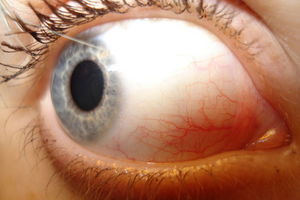That headache behind your eye or strange lines you are seeing may not mean you have a physical problem with your eyes. It may be an ophthalmic migraine. These eye aches are actually common and sometimes painless despite the title of migraine attached to this condition.
Eye migraines have visual symptoms with or without the pain. This is thought to have something to do with the way blood is flowing through the brain. These are officially known as migraines but they are often incorrectly called “ocular migraines.Like all migraines ophthalmic migraines can be triggered by a vast number of different things. Some people have ophthalmic migraine triggered by flashing light, certain smells , foods or hormone changes.
Migraines in general are just a neurological reaction caused by individual triggers that tend to be very particular to to the sufferer. Pain and visual changes can last for hours or even days in they are left untreated. The ophthalmic migraine ,just simply means the blood flow in the brain such as the visual cortex or occipital lobe is involved .Those without a headache may interpret the vision change as a result of damage to the eye. Ocular changes do to ophthalmic migraine are not long term and will cease once the blood flow is normalized.
The symptoms of an ophthalmic migraine are an enlarging blind spot, flickering lights, or lightening bolt type lines in your central visual field. Vision changes may last a few minutes or longer. It is most common for severe visual symptoms to dissipate after about twenty minutes. Vision changes with or without pain need to be looked at by a physician when they first occur. Some symptoms of more serious conditions like a detached retina have very similar symptoms and only an ophthalmologist can say for sure what the source of sudden vision change is.
The ophthalmologist may be able to determine that you are suffering from an ophthalmic migraine but he will be limited in the treatment he can offer. If ophthalmic migraines continue then you can consult your family physician for medications that shorten migraines in general. Keeping a migraine diary may help you find the trigger for your ophthalmic migraine, then you can limit you exposure to that trigger. If you experience dramatic vision changes during a migraine episode you will want to avoid driving or other activities that require clear vision during the migraine attack.
There are now several medications available that can halt a migraine in its track. Some people find that drinking lots of fluids ,if they are not nauseated ,during a migraine seems to help. Many find that using a cold compress over their eyes and lying in a dark room till the migraine passes or lessens helpful. Very intense migraines that do not subside and cause pain that can not be tolerated can be treated at the emergency room, but this should only be used as a last resort A trip to the ER is only necessary when other pain management efforts have failed.
http://www.mayoclinic.com/health/migraine-with-aura/DS00908 definition of an ocular migraine
http://www.mayoclinic.com/health/ocular-migraine/AN01681 Mayo clinic information on optical changes during a migraine.
http://www.ehow.com/how_2051941_treat-ocular-migraines.html?ref=fuel&utm;_source=yahoo&utm;_medium=ssp&utm;_campaign=yssp_art How to deal with an ocular migraine





